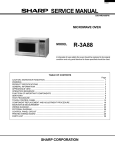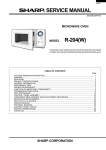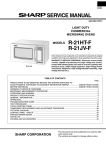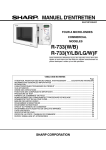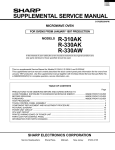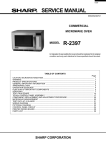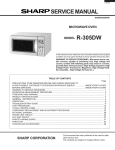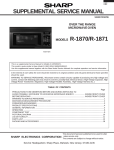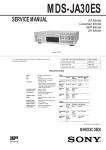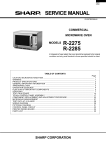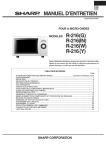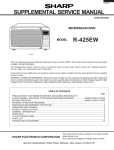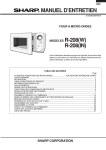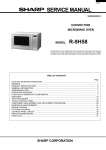Download Sharp R-3S68 Service manual
Transcript
R-3S68 SERVICE MANUAL S3612R3S68PX/ MICROWAVE OVEN MODEL R-3S68 In interests of user-safety the oven should be restored to its original condition and only parts identical to those specified should be used. TABLE OF CONTENTS Page CAUTION, MICROWAVE RADIATION ................................................................................................................. 1 WARNING .............................................................................................................................................................. 1 PRODUCT SPECIFICATIONS ............................................................................................................................. 2 GENERAL INFORMATION .................................................................................................................................... 2 APPEARANCE VIEW ........................................................................................................................................... 3 OPERATION SEQUENCE .................................................................................................................................... 4 FUNCTION OF IMPORTANT COMPONENTS ..................................................................................................... 5 SERVICING .......................................................................................................................................................... 6 TEST PROCEDURE ............................................................................................................................................. 8 TOUCH CONTROL PANEL ................................................................................................................................. 14 COMPONENT REPLACEMENT AND ADJUSTMENT PROCEDURE ............................................................... 18 MICROWAVE MEASUREMENT ........................................................................................................................ 24 WIRING DIAGRAM ............................................................................................................................................. 25 PICTORIAL DIAGRAM ....................................................................................................................................... 26 CONTROL PANEL CIRCUIT ............................................................................................................................... 27 PRINTED WIRING BOARD ................................................................................................................................. 28 PARTS LIST ....................................................................................................................................................... 29 SHARP CORPORATION R-3S68 R-3S68 SERVICE MANUAL PRODUCT SPECIFICATIONS MICROWAVE OVEN R-3S68 GENERAL IMPORTANT INFORMATION APPEARANCE VIEW This Manual has been prepared to provide Sharp Corp. Service engineers with Operation and Service Information. It is recommended that service engineers carefully study the entire text of this manual, so they will be qualified to render satisfactory customer service. CAUTION MICROWAVE RADIATION DO NOT BECOME EXPOSED TO RADIATION FROM THE MICROWAVE GENERATOR OR OTHER PARTS CONDUCTING MICROWAVE ENERGY. Service engineers should not be exposed to the microwave energy which may radiate from the magnetron or other microwave generating devices if it is improperly used or connected. All input and output microwave connections, waveguides, flanges and gaskets must be secured. Never operate the device without a microwave energy absorbing load attached. Never look into an open waveguide or antenna while the device is energized. WARNING Never operate the oven until the following points are ensured. (A) The door is tightly closed. (B) The door brackets and hinges are not defective. (C) The door packing is not damaged. (D) The door is not deformed or warped. (E) There is not any other visible damage with the oven. Servicing and repair work must be carried out only by trained service engineers. OPERATING SEQUENCE FUNCTION OF IMPORTANT COMPONENTS SERVICING AND TROUBLESHOOTING CHART TEST PROCEDURE TOUCH CONTROL PANEL ASSEMBLY COMPONENT REPLACEMENT AND ADJUSTMENT PROCEDURE MICROWAVE MEASUREMENT WIRING DIAGRAM All the parts marked "*" on parts list are used at voltages more than 250V. Removal of the outer wrap gives access to potentials above 250V. All the parts marked "∆" on parts list may cause undue microwave exposure, by themselves, or when they are damaged, loosened or removed. SHARP CORPORATION OSAKA, JAPAN 1 PARTS LIST R-3S68 PRODUCT SPECIFICATIONS ITEM Power Requirements Power Consumption Power Output Case Dimensions Cooking Cavity Dimensions Turntable diameter Control Complement Set Weight DESCRIPTION 220 Volts 50 Hertz Single phase, 3 wire earthed 1.37kW 850 watts nominal of RF microwave energy (IEC 705) Operating fequency 2450 MHz Width 520 mm Height 305 mm including foot Depth 389 mm Width 348 mm Height 197 mm Depth 368 mm 325mm Touch Control System Clock ( 1:00 - 12:59) Timer (0 - 99 minutes 90 seconds) Microwave Power for Variable Cooking Repetition Rate; HIGH ............................................... Full power throughout the cooking time MEDIUM HIGH ..................................................approx. 70% of Full Power MEDIUM ............................................................. approx. 50% of Full Power MEDIUM LOW .................................................... approx. 30% of Full Power LOW .................................................................... approx. 10% of Full Power TIME pads AUTO COOK pad AUTO DEFROST pad STOP/CLEAR pad POWER LEVEL /SERVE pad INSTANT COOK / START pad Approx. 15 kg GENERAL INFORMATION WARNING THIS APPLIANCE MUST BE EARTHED IMPOTANT THE WIRES IN THIS MAINS LEAD ARE COLOURED IN ACCORDANCE WITH THE FOLLOWING CODE: GREEN-AND-YELLOW BLUE BROWN 2 : EARTH : NEUTRAL : LIVE R-3S68 Ventilation openings Oven lamp Door hinges Door safety latches See through door Door seals and sealing surfaces 7. Coupling 8. Door open button 9. Touch control panel 10.Digital readout 11.Wave guide cover 12.Power supply cord 13.Rating label 14.Earth wire APPEARANCE VIEW 1. 2. 3. 4. 5. 6. 6 1 10 9 3 14 8 4 7 5 12 2 11 4 13 TOUCH CONTROL PANEL 1O 1 MIN. MIN. AUTO COOK PAD Press to select AUTO COOK menu. AUTO AUTO DEFROST PAD Press to defrost meat. AUTO STOP/CLEAR PAD Press to clear during programming. Press once to stop operation of oven during cooking; press twice to cancel cooking programme. AUTO COOK MENUS 1O SEC. TIME PADS Press to enter cooking time or clock time. COOK DEFROST STOP CLEAR POWER LEVEL SERVE INSTANT COOK START A1 Rice A2 Congee / Chicken Sour Soup A3 Porridge A4 Noodles A5 Shark's Fin Soup / Beef Soup A6 Steamed Fish A7 Dim Sum Delight A8 Sticky Rice 3 INSTANT COOK / START PAD Press once to cook for 1 minute at 100% or increase by 1 minute multiples each time this pad is pressed during cooking. Press to start oven after setting programmes. POWER LEVEL / SERVE PAD Press to set clock. Press to select microwave power setting. If not pressed; 100% is automatically selected. Press to enter serves after selecting AUTO COOK menu or pressing the AUTO DEFROST pad. R-3S68 OPERATION SEQUENCE OFF CONDITION The circuits to the power transformer, fan motor and turntable motor are cut off when the 1st. latch switch and 2nd. interlock relay control switch are made open. The oven lamp remains on even if the oven door is opened after the cooking cycle has been interrupted, because the relay RY1 stays closed. Shown in the display is the remaining time. Closing the door activates all door interlock switches (1st. latch switch and 2nd. interlock relay control switch). IMPORTANT When the oven door is closed, the monitor switch contacts (COM-NC) must be open. When the microwave oven is plugged in a wall outlet, rated voltage is supplied to the point A3+A5 in the control unit. 6. MONITOR SWITCH CIRCUIT The monitor switch is mechanically controlled by oven door, and monitors the operation of the 1st latch switch. 6-1 When the oven door is opened during or after the cycle of a cooking program, the 1st. latch switch and 2nd. interlock relay control switch must open their contacts first. After that the contacts (COM-NC) of the monitor switch can be closed. 6-2. When the oven door is closed, the contacts (COM-NC) of the monitor switch must be opened. After that the contacts of the 1st. latch switch and 2nd. interlock relay control switch are closed. 6-3. When the oven door is opened and the contacts of the 1st. latch switch and 2nd. interlock relay remain closed. The fuse M8A will blow, because the monitor switch is closed and a short circuit is caused. Figure O-1 on page 25 1. The display flashes 88:88 . 2. To set any programmes or set the clock, you must first touch the STOP/CLEAR pad. 3. : appears in the display. NOTE: When the oven door is opened, the oven lamp comes on at this time. MICROWAVE COOKING CONDITION HIGH COOKING Enter a desired cooking time with the touching NUMBER pad and start the oven with touching START pad. Function sequence Figure O-2 on page 25 CONNECTED COMPONENTS Oven lamp, Fan motor, Turntable motor Power transformer RELAY RY1 RY2 MEDIUM HIGH, MEDIUM, MEDIUM LOW, LOW COOKING When the microwave oven is preset for variable cooking power, rated voltage is supplied to the power transformer intermittently within a 32-second time base through the relay contact which is coupled with the current-limiting relay. The following levels of microwave power are given. 1. Rated voltage is supplied to the primary winding of the power transformer. The voltage is converted to about 3.3 volts A.C. output on the filament winding and high voltage of approximately 2000 volts A.C. on the secondary winding. 2. The filament winding voltage (3.3 volts) heats the magnetron filament and the high voltage (2000 volts) is sent to the voltage doubling circuit, where it is doubled to negative voltage of approximately 4000 volts D.C.. 3. The 2450 MHz microwave energy produced in the magnetron generates a wave length of 12.24 cm. This energy is channelled through the waveguide (transport channel) into the oven cavity, where the food is placed to be cooked. 4. When the cooking time is up, a signal tone is heard and the relays RY1+RY2 go back to their home position. The circuits to the oven lamp, power transformer, fan motor and turntable motor are cut off. 5. When the door is opened during a cook cycle, the switches come to the following condition SWITCH CONTACT CONDITION DURING COOKING 1st. latch switch 2nd. interlock relay control switch COM-NO Closed Open COM-NO Closed Open Monitor switch COM-NC Open Closed SETTING; 32 sec. ON HIGH 24 sec. ON 8 sec. OFF Approx. 70% MEDIUM HIGH 18 sec. ON 14 sec. OFF MEDIUM Approx. 50% 12 sec. ON 20 sec. OFF Approx. 30% MEDIUM LOW 6 sec. ON LOW 26 sec. OFF Approx. 10% NOTE: The ON/OFF time ratio does not exactly correspond to the percentage of microwave power, because approx. 2 seconds are needed for heating up the magnetron filament. DOOR OPEN (NO COOKING) 4 R-3S68 FUNCTION OF IMPORTANT COMPONENTS DOOR OPEN MECHANISM FUSE M8A The door is opened by pushing the open button on the control panel, refer to the Figure D-1. When the open button is pushed, the open button pushes up the switch lever, and then the switch lever pushes up the latch head. The latch heads are moved upward and released from latch hook. Now the door will open. 1. The fuse M8A blows when the contacts (COM-NO) of the 1st. latch switch and 2nd. interlock relay remain closed with the oven door open and when the monitor switch closes. 2. If the wire harness or electrical components are shortcircuited, this fuse M8A blows to prevent an electric shock or fire hazard. LATCH HOOK THERMAL CUT-OUT TC 145˚C (MG) LATCH HEADS SWITCH LEVER This thermal cut-out protects the magnetron against overheating. If the temperature goes up higher than 145˚C because the fan motor is interrupted, the ventilation openings are blocked, the thermal cut-out will open and the line voltages to the power transformer will be cut off and the operation of the magnetron will be stopped. The defective thermal cut-out must be replaced with new one. 2ND. INTERLOCK RELAY CONTROL SWITCH THERMAL CUT-OUT TC 145˚C (OVEN) MONITOR SWITCH The thermal cut-out located on the top of the oven cavity is designed to prevent damage to the oven if the foods in the oven catch fire due to over heating produced by improper setting of cook time or failure of control unit. Under normal operation, the oven thermal cut-out remains closed. However, when abnormally high temperatures are reached within the oven cavity, the oven thermal cut-out will open at 145˚C, causing the oven to shut down. The defective thermal cut-out must be replace with new one. 1ST. LATCH SWITCH Figure D-1. Door Open Mechanism 1ST. LATCH SWITCH AND 2ND. INTERLOCK RELAY CONTROL SWITCH 1. When the oven door is closed, the contacts COM-NO) must be closed. 2. When the oven door is opened, the contacts .(COM-NO) must be opened. THERMAL CUT-OUT 95˚C (FAN MOTOR) The thermal cut-out protect the fan motor against overheating. If its temperature goes up higher than 95˚C because the fan motor is locked or the ventilation operating are blocked, the contacts of the thermal cut-out will open and switch off the oven. When the oven cools itself down to 75˚C, the contacts of the thermal cut-out will close again. MONITOR SWITCH 1. When the oven door is closed, the contacts (COM-NC) must be opened. 2. When the oven door is opened, the contacts (COM-NC) must be closed. 3. If the oven door is opened and the contacts (COM-NO) of the 1st. latch switch and 2nd. interlock relay fail to open, the fuse M8A blows simultaneously with closing the contacts (COM-NC) of the monitor switch. CAUTION: BEFORE REPLACING A BLOWN FUSE M8A TEST THE 1ST. LATCH SWITCH, MONITOR SWITCH, 2ND. INTERLOCK RELAY, 2ND. INTERLOCK RELAY CONTROL SWITCH AND MONITOR RESISTOR FOR PROPER OPERATION. TURNTABLE MOTOR The turntable motor drives the turntable roller assembly to rotate the turntable. FAN MOTOR The fan motor drives a blade which draws external cool air. This cool air is directed through the air vanes surrounding the magnetron and cools the magnetron. This air is channelled through the oven cavity to remove steam and vapours given off from the heating foods. It is then exhausted through the exhausting air vents at the oven cavity MONITOR RESISTOR R 0.8Ω 20W The monitor resistor prevents the fuse M8A bursting when the fuse M8A blows due to the operation of the monitor switch. 5 R-3S68 SERVICING WARNING TO SERVICE PERSONNEL Microwave ovens contain circuitry capable of producing very high voltage and current, contact with any part of the high voltage circuit will result in electrocution. High voltage capacitor, Power transformer, Magnetron, High voltage rectifier assembly, High voltage harness. REMEMBER TO CHECK 3D REMEMBER TO CHECK 4R 1) Disconnect the supply. 2) Door opened, and wedged open. 3) Discharge high voltage capacitor. 1) Reconnect all leads removed from components during testing. 2) Replace the outer case (cabinet). 3) Reconnect the supply. 4) Run the oven. Check all functions. WARNING: AGAINST THE CHARGE OF THE HIGH-VOLTAGE CAPACITOR Microwave ovens should not be run empty. To test for the presence of microwave energy within a cavity, place a cup of cold water on the oven turntable, close the door and set the microwave timer for two (2) minutes. Set the power level to HIGH and push the START button. When the two minutes has elapsed (timer at zero) carefully check that the water is now hot. If the water remains cold carry out 3D checks and re-examine the connections to the component being tested. The high-voltage capacitor remains charged about 60 seconds after the oven has been switched off. Wait for 60 seconds and then short-circuit the connection of the high-voltage capacitor (that is, of the connecting lead of the high-voltage rectifier) against the chassis with the use of an insulated screwdriver. Sharp recommend that wherever possible fault-finding is carried out with the supply disconnected. It may in, some cases, be necessary to connect the supply after the outer case has been removed, in this event carry out 3D checks and then disconnect the leads to the primary of the power transformer. Ensure that these leads remain isolated from other components and the oven chassis. (Use insulation tape if necessary.) When the testing is completed carry out 3D checks and reconnect the leads to the primary of the power transformer. When all service work is completed, and the oven is fully assembled, the microwave power output should be checked and microwave leakage test carried out TROUBLESHOOTING GUIDE When troubleshooting the microwave oven, it is helpful to follow the Sequence of Operation in performing the checks. Many of the possible causes of trouble will require that a specific test be performed. These tests are given a procedure letter which will be found in the "Test Procedure"section. IMPORTANT: If the oven becomes inoperative because of a blown fuse M8A in the 1st. latch switch - 2nd. interlock relay - monitor switch monitor resistor circuit, check the 1st. latch switch, 2nd. interlock relay, 2nd. interlock relay control switch, monitor switch and monitor resistor before replacing the fuse M8A. 6 R-3S68 CK = Check / RE = Replace Home fuse blows when power supply cord is plugged into wall outlet. FUSE M8A blows when power supply cord is plugged into wall outlet. OFF CONDITION Display does not show anything when power supply cord is plugged into wall outlet. Display does not operate properly when STOP/CLEAR pad is touched. Oven lamp does not light at door opened. (Display appears.) Oven does not start when the START pad is touched. (Display appears) Oven lamp does not light (Display appears.) Fan motor does not operate. (Display appears.) Turntable motor assembly does not operate. (Display appears.) Oven or any electrical parts does not stop when cooking time is 0 or STOP/CLEAR pad is touched. ON CONDITION Oven seems to be operating but little or no heat is produced in oven load. (Microwave power level is set at HIGH) Oven does not seems to be operating properly when MEDIUM HIGH, MEDIUM, MEDIUM LOW or LOW is set. (Oven operates properly at HIGH and when the STOP/CLEAR pad is touched the oven stops.) Oven goes into cook cycle but shuts down before end of cooking cycle. 7 BLOCKED VENTILATION BLOCKED COOLING FAN MISADJUSTMENT SWITCH HOME FUSE OR BREAKER WALL OUTLET OVEN LAMP OR SOCKET SHORTED WIRE HARNESS OPENED WIRE HARNESS RECKCKRE CK CKCKCK CK POWER SUPPLY CORD RELAY (RY-1, RY-2) FOIL PATERN ON P.W.B. TACT SWITCH TOUCH CONTROL PANEL TURNTABLE MOTOR FUSE M8A FAN MOTOR MONITOR RESISTOR THERMAL CUT-OUT 95˚C THERMAL CUT-OUT 145˚C PROBLEM POWER TRANSFORMER H.V. RECTIFIER ASSEMBLY CONDITION MAGNETRON POSSIBLE CAUSE AND DEFECTIVE PARTS 1ST. LATCH SWITCH 2ND. INTERLOCK RELAY CONTROL SWITCH MONITOR SWITCH A B C D E E E G F F H H I K L M N HIGH VOLTAGE CAPACITOR TEST PROCEDURE R-3S68 TEST PROCEDURES PROCEDURE LETTER A COMPONENT TEST MAGNETRON TEST NEVER TOUCH ANY PART IN THE CIRCUIT WITH YOUR HAND OR AN INSULATED TOOL WHILE THE OVEN IS IN OPERATION. CARRY OUT 3D CHECK. Isolate the magnetron from high voltage circuit by removing all leads connected to filament terminal. To test for an open circuit filament use an ohmmeter to make a continuity test between the magnetron filament terminals, the meter should show a reading of less than 1 ohm. To test for short filament to anode condition, connect ohmmeter between one of the filament terminals and the case of the magnetron (ground). This test should be indicated an infinite resistance. If a low or zero resistance reading is obtained then the magnetron should be replaced. MICROWAVE OUTPUT POWER (IEC 705) The following test procedure should be carried out with the microwave oven in a fully assembled condition (outer case fitted). Microwave output power from the magnetron can be measured by way of IEC 705, i.e. it can be measured by using water load how much it can be absorbed by the water load. To measure the microwave output power in the microwave oven, the relation of calorie and watt is used. When P(W) heating works for t(second), approximately P x t/4.187 calorie is generated. On the other hand, if the temperature of the water with V(ml) rises ∆T (°C) during this microwave heating period, the calorie of the water is V x ∆T. The formula is as follows; P x t / 4.187 = V x ∆ T P (W) = 4.187 x V x ∆T / t Our condition for water load is as follows: Room temperature..............around 20°C Power supply Voltage.........Rated voltage Water load.........1000 g Initial temperature...........10±2°C Heating time.........49 sec. P = 85 x ∆T Measuring condition: 1. Container The water container must be a cylindrical borosilicate glass vessel having a maximum material thickness of 3 mm and an outside diameter of approximately 190 mm. 2. Temperature of the oven and vessel The oven and the empty vessel are at ambient temperature prior to the start the test. 3. Temperature of the water The initial temperature of the water is (10±2)°C. 4. Select the initial and final water temperature so that the maximum difference between the final water temperature and the ambient temperature is 5˚C. 5. Select stirring devices and measuring instruments in order to minimize addition or removal of heat. 6. The graduation of the thermometer must be scaled by 0.1°C at minimum and accurate thermometer. 7. The water load must be (1000±5) g. 8. “t” is measured while the microwave generator is operating at full power. Magnetron filament heatup time is not included. NOTE: The operation time of the microwave oven is “t + 2” sec. 2 sec. is magnetron filament heat-up time. Measuring method: 1. Measure the initial temperature of the water before the water is added to the vessel. (Example: The initial temperature T1 = 11°C) 2. Add the 1 litre water to the vessel. 3. Place the load on the centre of the shelf. 4. Operate the microwave oven at HIGH for the temperature of the water rises by a value ∆ T of (10 ± 2)˚C. 5. Stir the water to equalize temperature throughout the vessel. 8 R-3S68 TEST PROCEDURES PROCEDURE LETTER COMPONENT TEST 6. Measure the final water temperature. (Example: The final temperature T2 = 21°C) 7. Calculate the microwave power output P in watts from above formula. Initial temperature .................................................................................................. T1 = 11°C Temperature after (49 + 2) = 51 sec. ..................................................................... T2 = 21°C Temperature difference Cold-Warm.................................................................... ∆T1 = 10°C Measured output power The equation is “P = 85 x ∆T” ...................................................... P = 85 x 10°C = 850 Watts JUDGMENT: The measured output power should be at least ± 15 % of the rated output power. CAUTION: 1°C CORRESPONDS TO 85 WATTS REPEAT MEASUREMENT IF THE POWER IS INSUFFICIENT. 1000g 1000g 1000g T1˚C T2˚C Heat up for 51 sec. B POWER TRANSFORMER TEST WARNING: High voltages and large currents are present at the secondary winding and filament winding of the power transformer. It is very dangerous to work near this part when the oven is on. NEVER make any voltage measurements of the high-voltage circuits, including the magnetron filament. CARRY OUT 3D CHECKS. Disconnect the leads to the primary winding of the power transformer. Disconnect the filament and secondary winding connections from the rest of the HV circuitry. Using an ohmmeter, set on a low range, it is possible to check the continuity of all three windings. The following readings should be obtained: a. Primary winding ....................approx. 1.4 Ω b. Secondary winding ............... approx. 98 Ω c. Filament winding ................... less than 1Ω If the reading obtained are not stated as above, then the power transformer is probably faulty and should be replaced. CARRY OUT 4R CHECKS. C HIGH VOLTAGE RECTIFIER ASSEMBLY TEST HIGH VOLTAGE RECTIFIER TEST CARRY OUT 3D CHECKS. Isolate the high voltage rectifier assembly from the HV circuit. The high voltage rectifier can be tested using an ohmmeter set to its highest range. Connect the ohmmeter across the terminal B+C of the high voltage rectifier and note the reading obtained. Reverse the meter leads and note this second reading. The normal resistance is infinite in one direction and more than 100 kΩ in the other direction. 9 R-3S68 TEST PROCEDURES (CONT'D) PROCEDURE LETTER COMPONENT TEST C B CARRY OUT 4R CHECKS. HIGH VOLTAGE RECTIFIER NOTE: FOR MEASUREMENT OF THE RESISTANCE OF THE RECTIFIER, THE BATTERIES OF THE MEASURING INSTRUMENT MUST HAVE A VOLTAGE AT LEAST 6 VOLTS, BECAUSE OTHERWISE AN INFINITE RESISTANCE MIGHT BE SHOWN IN BOTH DIRECTIONS. D HIGH VOLTAGE CAPACITOR TEST CARRY OUT 3D CHECKS. A. Isolate the high voltage capacitor from the circuit. B. Continuity check must be carried out with measuring instrument which is set to the highest resistance range. C. A normal capacitor shows continuity for a short time (kick) and then a resistance of about 10MΩ after it has been charged. D. A short-circuited capacitor shows continuity all the time. E. An open capacitor constantly shows a resistance about 10 MΩ because of its internal 10MΩ resistance. F. When the internal wire is opened in the high voltage capacitor shows an infinite resistance. G. The resistance across all the terminals and the chassis must be infinite when the capacitor is normal. If incorrect reading are obtained, the high voltage capacitor must be replaced. CARRY OUT 4R CHECKS. E SWITCH TEST CARRY OUT 3D CHECKS. Isolate the switch to be tested and using an ohmmeter check between the terminals as described in the following table. COM; Common terminal, Table: Terminal Connection of Switch Plunger Operation Released Depressed COM to NO O.C. S.C. COM to NC S.C. O.C. NO; NC; S.C.; O.C.; Normally open terminal Normally close terminal Short, Open circuit If incorrect readings are obtained, make the necessary switch adjustment or replace the switch. CARRY OUT 4R CHECKS. F THERMAL CUT-OUT TEST CARRY OUT 3D CHECKS. Disconnect the leads from the terminals of the thermal cut-out. Then using an ohmmeter, make a continuity test across the two terminals as described in the table below. CARRY OUT 4R CHECKS .Table: Thermal cut-out Test Parts Name Temperature of "ON" condition (closed circuit) (˚C) Temperature of "OFF" condition (open circuit) (˚C) Thermal cut-out 145˚C Thermal cut-out 95˚C This is not resetable type Below 75˚C Above 145˚C Above 95˚C Indication ofohmmeter (When room temperature is approx. 20˚C) Closed circuit. Closed circuit. If incorrect readings are obtained, replace the thermal cut-out. An open circuit thermal cut-out 145˚C (MG) indicates that the magnetron has overheated, this may be due to resistricted ventilation, cooling fan failure or a fault condition within the magnetron or HV circuit. An open circuit thermal cut-out 145˚C (OVEN) indicates that the foods in the oven may catch fire, this may be due to over heating produced by improper setting of the cooking time or failure of the control panel. An open circuit thermal cut-out 95˚C (FAN) indicates that the fan motor winding has overheated, this may be due to blocked ventilation or locked cooling fan. 10 R-3S68 TEST PROCEDURES (CONT'D) PROCEDURE LETTER G COMPONENT TEST MONITOR RESISTOR TEST CARRY OUT 3D CHECKS. Disconnect the leads from the monitor resist. Using an ohmmeter and set on a low range. Check between the terminals of the monitor resistor. The resistance of monitor resistor is approx. 0.8 ohms. If incorrect readings are obtained, replace the monitor resistor. CARRY OUT 4R CHECKS. H MOTOR WINDING TEST CARRY OUT 3D CHECKS. Disconnect the leads from the motor. Using an ohmmeter, check the resistance between the two terminals as described in the table below. Table: Resistance of Motor Motors Resistance Fan motor Approximately 370 Ω Turntable motor Approximately 16.08 kΩ If incorrect readings are obtained, replace the motor. I CARRY OUT 4R CHECKS BLOWN FUSE F M8A CARRY OUT 3D CHECKS. 1. If the fuse M8A is blown, there could be shorts or ground in electrical parts or wire harness. Check them and replace the defective parts or repair the wire harness. 2. If the fuse M8A is blown when the door is opened, check the 1st. latch switch, 2nd. interlock relay, 2nd. interlock relaycontrol switch, monitor switch and monitor resistor. If the fuse M8A is blown by incorrect door switching replace the defective switch(s) and the fuse M8A. CARRY OUT 4R CHECKS. CAUTION: ONLY REPLACE FUSE M8A WITH THE CORRECT VALUE REPLACEMENT. J TOUCH CONTROL PANEL ASSEMBLY TEST The touch control panel consists of circuits including semiconductors such as LSI, ICs, etc. Therefore, unlike conventional microwave ovens, proper maintenance cannot be performed with only a voltmeter and ohmmeter. In this service manual, the touch control panel assembly is in one unit, and troubleshooting by unit replacement is described according to the symptoms indicated. 1. Tact Switch. The following symptoms indicate a defective tact switch. Replace the tact switch. a) When touching the tact switches, a certain tact switch produces no signal at all. b) When touching the tact switches, sometimes a tact switch produces no signal. 2. Control Panel The following symptoms may indicate a defective control unit. Before replacing the control unit, perform the tact switch test (Procedure K) to determine if control unit is faulty. 2-1 In connection with tact switches. a) When touching the tact switches, a certain group of tact switches do not produce a signal. b) When touching the tact switches, no tact switches produce a signal. 11 R-3S68 TEST PROCEDURES (CONT'D) PROCEDURE LETTER COMPONENT TEST 2-2 In connection with indicators a) At a certain digit, all or some segments do not light up. b) At a certain digit, brightness is low. c) Only one indicator does not light. d) The corresponding segments of all digits do not light up or they continue to light up. e) Wrong figure appears. f) A certain group of indicators do not light up. g) The figure of all digits flicker. 2-3 Other possible problems caused by defective control unit. a) Buzzer does not sound or continues to sound. b) Cooking is not possible. K TACT SWITCH TEST If the display fails to clear when the STOP/CLEAR tact switch is depressed, first verify that the door sensing switch (stop switch) operates properly; that is the contacts are closed when the door is closed and open when the door is open. If the door sensing switch (stop switch) is good, make sure the door sensing switch is closed (either close the door or short the door sensing switch connecter). Use the tact switch matrix indicated on the control panel schematic and place a jumper wire between the pins that correspond to the STOP/CLEAR tact switch making momentary contact. If the control unit responds by clearing with a beep, the tact switch is faulty and must be replaced. If the control unit does not respond, it is a faulty and must be replaced. If a specific pad does not respond, the above method may be used (after clearing the control unit) to determine if the control unit or tact switch is at fault. SW1 10 MIN. SW2 1 MIN. SW5 SW4 AUTO COOK SW3 SW6 AUTO DEFROST 10 SEC. STOP CLEAR SW7 POWER SW8 INSTANT LEVEL SERVE L COOK START RELAY TEST CARRY OUT 3D CHECKS. Remove the outer case and check voltage between Pin Nos. 3 and 5 of the 3 pin connector (A) on the control unit with an A.C. voltmeter. The meter should indicate 220 volts, if not check oven circuit. RY1 and RY2 Relay Test These relays are operated by D.C. voltage. Check voltage at the relay coil with a D.C. voltmeter during the microwave cooking or convection cooking operation. DC. voltage indicated .................... Defective relay. DC. voltage not indicated . ............ Check diode which is connected to the relay coil. If diode is good, control unit is defective. RELAY SYMBOL OPERATIONAL VOLTAGE CONNECTED COMPONENTS RY1 APPROX. 19.0V D.C. Oven lamp / Turntable motor / Cooling fan motor RY2 APPROX. 18.0V D.C. Power transformer CARRY OUT 4R CHECKS. 12 R-3S68 TEST PROCEDURES (CONT'D) PROCEDURE LETTER M COMPONENT TEST PROCEDURES TO BE TAKEN WHEN THE FOIL PATTERN ON THE PRINTED WIRING BOARD (PWB) IS OPEN To protect the electronic circuits, this model is provided with a fine foil pattern added to the primary on the PWB, this foil pattern acts as a fuse. If the foil pattern is open, follow the troubleshooting guide given below for repair. Problem: POWER ON, indicator does not light up. CARRY OUT 3D CHECKS. STEPS 1 OCCURANCE CAUSE OR CORRECTION 3 The rated voltage is not applied to POWER terminal of CPU connector (CN-A). The rated voltage is applied to primary side of low voltage transformer. Only pattern at "a" is broken. 4 Pattern at "a" and "b" are broken. 2 Check supply voltage and oven main unit. Low voltage transformer or secondary circuit defective. Check and repair. *Insert jumper wire J1 and solder. (CARRY OUT 3D CHECKS BEFORE REPAIR) *Insert the coil RCILF2003YAZZ between "c" and "d". (CARRY OUT 3D CHECKS BEFORE REPAIR) d LEAD WIRE CARRY OUT 4R CHECKS. 13 (J1) c CN - A b a VRS1 LEAD WIRE GREEN RY1 D22 RY2 2 NOTE: At the time of these repairs, make a visual inspection of the varistor for burning damage and examine the transformer with tester for the presence of layer shortcircuit (check primary coil resistance). If any abnormal condition is detected, replace the defective parts. 5 1 3 POWER OL TTM R-3S68 TOUCH CONTROL PANEL ASSEMBLY OUTLINE OF TOUCH CONTROL PANEL 5) ACL Circuit A circuit to generate a signals which resets the LSI to the initial state when power is supplied. Control Unit Control unit consists of tact switches, LSI, power source circuit, synchronizing signal circuit, ACL circuit, buzzer circuit and indicator circuit. 6) Buzzer Circuit The buzzer is responsive to signals from the LSI to emit noticing sounds (key touch sound and completion sound). 1) Tact Switches The tact switches are composed of a matrix, signals generated in the LSI are sent to the tact switches through R61-R63. When a tact switches is touched, a signal is completed through the tact switches and passed back to the LSI through R81-R83 to perform the function that was requested. 7) Door Sensing Switch A switch to “tell” the LSI if the door is open or closed. 8) Relay Circuit To drive the magnetron, fan motor, turntable motor and light the oven lamp. 2) LSI This LSI controls the key strobe signal, relay driving signal for oven function and indicator signal. 9) Indicator Circuit Indicator element is a Light-emitting diode. Basically, a Light-emitting diode is triode having a cathode and an anode. The Light-emitting diode has 4-digits, 9-segments are used for displaying figures. 3) Power Source Circuit This circuit generates voltages necessary in the control unit. Symbol VC Voltage -5V Application LSI(IC1) 4) Synchronizing Signal Circuit The power source synchronizing signal is available in order to compose a basic standard time in the clock circuit. It accompanies a very small error because it works on commercial frequency. 14 R-3S68 DESCRIPTION OF LSI LSI(IZA677DR) The I/O signal of the LSI(IZA677DR) is detailed in the following table. Pin No. Signal I/O Description 1 XOUT OUT 2 XIN IN Internal clock oscillation frequency input setting. The internal clock frequency is set by inserting the ceramic filter oscillation circuit with respect to XIN terminal. 3 RESET IN Auto clear terminal. Signal is input to reset the LSI to the initial state when power is supplied. Temporarily set to “L” level the moment power is supplied, at this time the LSI is set. Thereafter set at “H” level. 4 R70 OUT Segment data signal. Refer to the touch control panel circuit for the relationship between signals and indicators. Normally, one pulse is output in every synchronized signal period, and input to the anode of the light -emitting diode. 5 PULSE OUT Signal to sound buzzer. Internal clock oscillation frequency control output. Output to control oscillation input of XOUT. A: key touch sound(0.12 sec.). B: Completion sound(2.4 sec.). 6 R72 OUT Digit selection signal. Refer to the touch control panel circuit about the relation between signals and digits. Normally, one pulse is output in every synchronized signal period, and input to the light -emitting diode. 7-9 R40-R42 OUT Digit selection signal. Refer to the touch control panel circuit about the relation between signals and digits. Normally, one pulse is output in every synchronized signal period, and input to the light -emitting diode. 10 AIN3 IN 11 R50 OUT Segment data signal. Signal similar to R70. R51-R52 OUT Segment data signal. Refer to the touch control panel circuit for the relationship between signals and indicators. Normally, one pulse is output in every synchronized signal period, and input to the anode of the light -emitting diode. 14 VSS IN 15 R53 OUT Segment data signal. Signal similar to R70. 16 R60 OUT Segment data signal. Signal similar to R70. 17 R61 OUT Segment data signal. Signal similar to R70. 12-13 Terminal to change cooking constant. Connected to VC. Switch strobe signal. Signal applied to tact switch section. A pulse signal is input to R81, R82 and R83 terminal while one of diode D56 line switches on switch matrix is touched. 18 R62 OUT Segment data signal. Signal similar to R70. Switch strobe signal. Signal applied to tact switch section. A pulse signal is input to R81, R82 and R83 terminal while one of diode D57 line switches on switch matrix is touched. 15 R-3S68 Pin No. 19 Signal R63 I/O OUT Description Segment data signal. Signal similar to R70. Switch strobe signal. Signal applied to tact switch section. A pulse signal is input to R81, R82 and R83 terminal while one of diode D58 line switches on switch matrix is touched. 20 INT2 IN Signal synchronized with commercial source frequency(50Hz). This is basic timing for time processing of LSI. 21 R81 IN Signal coming from touch tact switch. When either one of resistor R80 line switches on switch matrix is touched, a corresponding signal out of R61-R63 will be input into R81. When no key is touched, the signal is held at "L" level. 22 R82 IN Signal coming from touch tact switch. When either one of resistor R81 line switches on switch matrix is touched, a corresponding signal out of R61-R63 will be input into R82. 23 R83 IN Signal coming from touch tact switch. When either one of resistor R82 line switches on switch matrix is touched, a corresponding signal out of R61-R63 will be input into R83. 24 R90 OUT Terminal not used. 25 R91 OUT Oven lamp, turntable motor and cooling fan motor driving signal. (Square Waveform : 50Hz) To turn on and off the control relay. The pulse signal (50Hz) is delivered to the control relay driving circuit and cook relay control circuit. 26 R92 OUT Magnetron high-voltage circuit driving signal. To turn on and off the cook relay. In 100% power operation, the signals holds “L” level during microwave cooking and “H” level while not cooking. In other cooking modes (10%, 30%, 50%, 70%) the signal turns to “H” level and “L” level in repetition according to the power level. 27 KE0 IN Input signal which communicates the door open/close information to LSI. Door closed; “H” level signal. Door opened; “L” level signal. 28 VDD IN Connected to GND. 16 R-3S68 SERVICING 1. Precautions for Handling Electronic Components This unit uses CMOS LSI in the integral part of the circuits. When handling these parts, the following precautions should be strictly followed. CMOS LSI have extremely high impedance at its input and output terminals. For this reason, it is easily influenced by the surrounding high voltage power source, static electricity charge in clothes, etc. and sometimes it is not fully protected by the built-in protection circuit. In order to protect CMOS LSI. 1) When storing and transporting, thoroughly wrap them in aluminium foil. Also wrap all PW boards containing them in aluminium foil. 2) When soldering, ground the technician as shown in the figure and use grounded soldering iron and work table. B. On some models, the power supply cord between the touch control panel and the oven proper is long enough that they may be separated from each other. For those models, therefore, it is possible to check and repair the controls of the touch control panel while keeping it apart from the oven proper; in this case you must short both ends of the door sensing switch (on PWB) of the touch control panel with a jumper, which brings about an operational state that is equivalent to the oven door being closed. As for the sensor-related controls of the touch control panel, checking them is possible if dummy resistor(s) with resistance equal to that of the controls are used. (2) Servicing the touch control panel with power supply from an external power source: Disconnect the touch control panel completely from the oven proper,and short both ends of the door sensing switch (on PWB) of the touch control panel,which brings about an operational state that is equivalent to the oven door being closed. Connect an external power source to the power input terminal of the touch control panel, then it is possible to check and repair the controls of the touch control panel it is also possible to check the sensorrelated controls of the touch control panel by using the dummy resistor(s). approx. 1M ohm 2. Shapes of Electronic Components 1 2 3 IC LM7905CT E CB Transistor KRA101M KRA222M KRA223M KRC243M 4. Servicing Tools Tools required to service the touch control panel assembly. 1) Soldering iron: 30W (It is recommended to use a soldering iron with a grounding terminal.) 2) Oscilloscope: Single beam, frequency range: DC-10MHz type or more advanced model. 3) Others: Hand tools 3. Servicing of Touch Control Panel We describe the procedures to permit servicing of the touch control panel of the microwave oven and the precautions you must take when doing so. To perform the servicing, power to the touch control panel is available either from the power line of the oven itself or from an external power source. (1) Servicing the touch control panel with power supply of the oven: CAUTION: THE HIGH VOLTAGE TRANSFORMER OF THE MICROWAVE OVEN IS STILL LIVE DURING SERVICING PRESENTS A HAZARD. Therefore, when checking the performance of the touch control panel, put the outer cabinet on the oven to avoid touching the high voltage transformer, or unplug the primary terminal (connector) of the high voltage transformer to turn it off; the end of such connector must be insulated with an insulating tape. After servicing, be sure to replace the leads to their original locations. A. On some models, the power supply cord between the touch control panel and the oven itself is so short that the two can’t be separated. For those models, check and repair all the controls (sensor-related ones included) of the touch control panel while keeping it connected to the oven. 5. Other Precautions 1) Before turning on the power source of the control unit, remove the aluminium foil applied for preventing static electricity. 2) After aluminium foil is removed, be careful that abnormal voltage due to static electricity etc. is not applied to the input or output terminals. 3) Attach connectors, electrolytic capacitors, etc. to PWB, making sure that all connections are tight. 4) Be sure to use specified components where high precision is required. 17 R-3S68 COMPONENT REPLACEMENT AND ADJUSTMENT PROCEDURE WARNING: Avoid possible exposure to microwave energy. Please follow the instructions below before operating the oven. 1. Disconnect oven from power supply. 2. Make sure that a definite” click” can be heard when the microwave oven door is unlatched. (Hold the door in a closed position with one hand, then push the door open button with the other, this causes the latch leads to rise, it is then possible to hear a “click’ as the door switches operate.) 3. Visually check the door and cavity face plate for damage (dents, cracks, signs of arcing etc.). 1. 2. 3. 4. 5. 6. Door does not close firmly. Door hinge, support or latch hook is damaged. The door gasket or seal or damaged. The door is bent or warped. There are defective parts in the door interlock system. There are defective parts in the microwave generating and transmission assembly. 7. There is visible damage to the oven. Do not operate the oven: 1. Without the RF gasket (Magnetron). 2. If the wave guide or oven cavity are not intact. 3. If the door is not closed. 4. If the outer case (cabinet) is not fitted. Carry out any remedial work that is necessary before operating the oven. Do not operate the oven if any of the following conditions exist; Please refer to ‘OVEN PARTS, CABINET PARTS, CONTROL PANEL PARTS, DOOR PARTS’, when carrying out any of the following removal procedures: OUTER CASE REMOVAL 6. Discharge the H.V. capacitor before carrying out any further work. 7. Do not operate the oven with the outer case removed. N.B.; Step 1, 2 and 6 form the basis of the 3D checks. To remove the outer case proceed as follows. 1. Disconnect oven from power supply. 2. Open the oven door and wedge it open. 3. Remove the six (6) screws from rear and along the right side edge of case. 4. Slide the entire case back about 3cm to free it from retaining clips on the cavity face plate. 5. Lift the entire case from the unit. CAUTION: DISCHARGE HIGH VOLTAGE CAPACITOR BEFORE TOUCHING ANY OVEN COMPONENT OR WIRING. MAGNETRON REMOVAL Removal 1. CARRY OUT 3D CHECKS. 2. Disconnect wire leads from magnetron. 3. Remove the two (2) screws holding chassis support to oven cavity front plate and magnetron. 4. Remove the chassis support from oven. 5. Carefully remove the two (2) screws holding magnetron to waveguide flange. 6. Lift up magnetron with care so that magnetron antenna is not hit by any metal object around antenna. 7. Now, the magnetron is free. Re-install 1. Re-install the magnetron to waveguide flange with the two (2) screws diagonally as shown in Figure C-1. 2. Re-install the chassis support to oven cavity front plate and magnetron with the two (2) screws. 3. Reconnect the wire leads to the magnetron. Refer to "PICTORIAL DIAGRAM". 4. Re-install outer case and check that the oven is operating properly. CAUTION: WHEN REPLACING MAGNETRON, BE SURE THE R.F. GASKET IS IN PLACE AND MOUNTING SCREWS ARE TIGHTENED SECURELY SCREWS MAGNETRON WAVEGUIDE FLANGE Figure C-1. Magnetron replacement POWER TRANSFORMER REMOVAL 1. CARRY OUT 3D CHECKS. 2. Disconnect wire leads from power transformer, magnetron and capacitor terminals. 3. Remove four (4) screws holding transformer to bottom plate right. 4. Remove transformer from bottom plate right. 5. Remove the one (1) terminal insulator from filament lead (longer one) of power transformer. 18 R-3S68 Re-install 1. Insert tube into filament lead (longer one) of power transformer. 2. Install the terminal insulator to receptacle of filament lead (longer one) of power transformer. 3. Rest transformer on the bottom plate right with its primary terminals toward the oven face plate. 4. Secure transformer with four screws to bottom plate right. 5. Re-connect wire leads (primary and high voltage) to power transformer and filament leads of transformer to magnetron and high voltage capacitor. Refer to "PICTORIAL DIAGRAM". 6. Re-install outer case and check that oven is operating properly. TERMINAL INSULATOR REPLACEMENT 1. Open covers of the terminal insulator by using small flat type screw driver. 2. Remove the receptacle from the terminal insulator. 3. Now, the terminal insulator is free. Installation 1. Insert the receptacle into terminal insulator. 2. Close covers of the terminal insulator, as shown illustrated below. COVERS Terminal insulator Flat type screw driver RECEPTACLE HIGH VOLTAGE RECTIFIER AND HIGH VOLTAGE CAPACITOR REMOVAL 1. CARRY OUT 3D CHECKS. 2. Disconnect the high voltage wire of the high voltage rectifier assembly from the magnetron. 3. Remove one (1) screw holding capacitor holder to oven cavity rear plate. 4. Remove one (1) screw holding high voltage rectifier assembly to capacitor holder. 5. Disconnect rectifier terminal from capacitor. 6. Now, high voltage rectifier assembly is free. 7. Disconnect wire leads from capacitor and remove capacitor holder. 8. Now, high voltage capacitor is free. CAUTION: WHEN REPLACING HIGH VOLTAGE RECTIFIER AND HIGH VOLTAGE CAPACITOR, GROUND SIDE TERMINAL OF THE HIGH VOLTAGE RECTIFIER MUST BE SECURED FIRMLY WITH A GROUNDING SCREW. POSITIVE LOCK® CONNECTOR REMOVAL Terminal Positive lock® connector 1. CARRY OUT 3D CHECKS. 2. Pushing the lever of positive lock® connector. 3. Pull out the positive lock® connector. 1 Push Lever CAUTION: WHEN YOU (SERVICE ENGINEERS) CONNECT THE POSITIVE LOCK® CONNECTORS TO THE TERMINALS, CONNECT THE POSITIVE LOCK® SO THAT THE LEVER FACE YOU (SERVICE ENGINEERS). 2 Pull down Figure C-2. Positive lock® connector CONTROL PANEL ASSEMBLY REMOVAL surfaces completely with a soft cloth soaked in alcohol. 2. When attaching the key sheet to the control panel frame, adjust the upper edge and right edge of the key sheet to the correct position of control panel frame. 3. Stick the key sheet firmly to the control panel frame by rubbing with soft cloth not to scratch. 1. CARRY OUT 3D CHECKS. 2. Disconnect wire leads from panel components. 3. Release one (1) nail holding the control panel assembly to the oven flange. 4. Remove control panel assembly and slide upward. 5 . Now, individual components can be removed. NOTE: 1. Before attaching a new key sheet, wipe off remaining adhesive on the control panel frame 19 R-3S68 TURNTABLE MOTOR REMOVAL 6. Remove two (2) screws holding turntable motor to oven cavity. 7. Now the turntable motor is free. 8. After replacement use the one (1) screw to fit the turntable motor cover. NOTE: The one (1) screw to fit the turntable motor cover should be XOTSD40P12000, XOTSD40P10000 or XOTSD40P08000. 1. Disconnect oven from power supply. 2. Remove turntable and turntable support from oven cavity. 3. Lay the oven on it's backside. Remove the turntable motor cover by snipping off the material in four corner. 4. Where the corners have been snipped off bend corner areas flat. No sharp edge must be evident after removal of the turntable motor cover. 5. Disconnect wire leads from turntable motor. (See "Positive lock connector removal") COOLING FAN MOTOR REMOVAL 9. Remove the two (2) screws holding the fan motor to the fan duct. 10.Now, the fan motor is free. 1. CARRY OUT 3D CHECKS. 2. Disconnect the wire leads from the fan motor, thermal cut-out (FAN) and magnetron. 3. Remove two (2) screws holding the chassis support to oven cavity front plate and magnetron. And remove chassis support. 4. Remove two (2) screws holding the magnetron to waveguide flange. And remove the magnetron. 5. Remove one (1) screw holding the fan duct assembly to oven cavity. 6. Release the fan duct assembly from the oven cavity. 7. Remove one (1) screw holding the thermal cut-out angle to the fan motor. 8. Remove the fan blade from the fan motor shaft according the following procedure. 1) Hold the edge of the rotor of the fan motor by using a pair of grove joint pliers. CAUTION: * Make sure that any pieces do not enter the gap between the rotor and the stator of the fan motor because the rotor is easily shaven by pliers and metal pieces may be produced. * Do not touch the pliers to the coil of the fan motor because the coil may be cut or injured. * Do not disfigure the bracket by touching with the pliers. 2) Remove the fan blade from the shaft of the fan motor by pulling and rotating the fan blade with your hand. 3) Now, the fan blade will be free. CAUTION: * Do not use this removed fan blade again because the hole (for shaft) of it may become bigger than a standard one. INSTALLATION 1. Install the fan motor to the fan duct with the two (2) screws. 2. Install the fan blade to the fan motor shaft according the following procedure. 1) Hold the centre of the bracket which supports the shaft of the fan motor on the flat table. 2) Apply the screw lock tight into the hole (for shaft) of the fan blade. 3) Install the fan blade to the shaft of fan motor by pushing the fan blade with a small, light weight, ball peen hammer or rubber mallet. CAUTION: * Do not hit the fan blade strongly when installed because the bracket may be disfigured. * Make sure that the fan blade rotates smooth after installation. * Make sure that the axis of the shaft is not slanted. 3. Install the thermal cut-out angle to the fan motor with one (1) screw. 4. Catch two holes of fan duct on two tabs of the waveguide flange. 5. Install the fan duct assembly to the oven cavity with the one (1) screw. 6. Install the magnetron to waveguide flange with two (2) screws. 7. Install one (1) tab of the chassis support to oven cavity front plate and install another tab of it to rear plate. And then screw chassis support to oven cavity front plate and magnetron with two (2) screws. 8. Connect the wire leads to the fan motor, magnetron and thermal cut-out (FAN), referring to the pictorial diagram. Coil Groove joint pliers Shaft Stator These are the position where should be pinched with pliers Axis Gap Bracket Shaft Rotor Stator Rotor Rear View Side View 20 Table Center of bracket R-3S68 OVEN LAMP AND LAMP SOCKET REMOVAL Oven lamp socket 1. CARRY OUT 3D CHECKS. 2. Pull the wire leads from the oven lamp socket by pushing the terminal hole of the oven lamp socket with the small flat type screw driver. 3. Bend the tab of the oven cavity holding the lamp socket. 4. Lift up the oven lamp socket. 5. Now, the oven lamp socket is free. Terminal Wire lead Terminal hole Flate type small screw driver Figure C-3. Oven lamp socket POWER SUPPLY CORD REPLACEMENT Removal 5. Wind the conductor of the blue wire lead of the power supply cord and the conductor of the wire lead of the main wire harness each other. 6. Insert them into the connector. And clamp it. 7. CARRY OUT 4R CHECKS. 1. CARRY OUT 3D CHECKS. 2. Remove the one (1) screw holding the green/yellow wire to the bottom plate right. 3. Disconnect the brown wire lead of the power supply cord from the fuse holder. 4. Cut away the connector. 5. Release the power supply cord from the rear cabinet. 6. Now, the power supply cord is free. Blue wire lead of power supply cord 15 mm Re-install Wire lead of the main wire harness 1. Insert the moulding cord stopper of power supply cord into the square hole of the rear cabinet. 2. Install the earth wire lead of power supply cord to the bottom plate rirgt with one (1) screw and tight the screw. 3. Connect the brown wire lead of power supply cord to the fuse holder correctly, referring to the Pictorial Diagram. 4. Strip the blue wire lead of the power supply cord and white wire lead of the main wire harness for 15mm lengh from their end. Connector CE-230 Conductor: Stripped portion Connector CE-230 Figure C-4. Power supply cord replacement 1ST. LATCH SWICTH, 2ND. INTERLOCK RELAY CONTROL SWITCH AND MONITOR SWITCH REMOVAL 1. CARRY OUT 3D CHECKS. 2. Disconnect wire leads from the switches. 3. Remove two (2) screws holding latch hook to oven flange. 4. Remove latch hook assembly from oven flange. 5. Push outward on the two (2) retaining tabs holding each switch in place. 6. Switches are now free. At this time switch lever will be free, do not lose it. Re-install 1. Re-install each switch and switch lever in its place. The 1st. latch switch and monitor switch are in the lower position and 2nd. interlock relay control switch is in the upper position. 2. Re-connect wire leads to each switch. Refer to pictorial diagram. 3. Secure latch hook (with two (2) mounting screws) to oven flange. 4. Make sure that the monitor switch is operating properly and check continuity of the monitor circuit. Refer to chapter "Test Procedure" and Adjustment procedure. 1ST. LATCH SWICTH, 2ND. INTERLOCK RELAY CONTROL SWITCH AND MONITOR SWITCH ADJUSTMENT If each switch does not operate properly due to a misadjustment, the following adjustment should be made. 1. Loosen the two (2) screws holding latch hook to the oven cavity front flange. 2. With door closed, adjust latch hook by moving it back and forth, and up and down. In and out play of the door allowed by the upper and lower position of the latch hook should be less than 0.5mm. The vertical position of the 21 R-3S68 4. Re-install outer case and check for microwave leakage around door with an approved microwave survey meter. (Refer to Microwave Measurement Procedure.) latch hook should be adjusted so that the 1st. latch switch 2nd. interlock relay control switch are activated with the door closed. The horizontal position of the latch hook should be adjusted so that the monitor switch is activated with the door closed. 3. Secure the screws with washers firmly. 4. Check the operation of all switches. If any switch has not activated with the door closed, loosen screw and adjust the latch hook position. LATCH HOOK 2ND. INTERLOCK RELAY CONTROL SWITCH LATCH HEADS After adjustment, check the following. 1. In and out play of door remains less than 0.5mm when in the latched position. First check upper position of latch hook, pushing and pulling upper portion of door toward the oven face. Then check lower portion of the latch hook, pushing and pulling lower portion of the door toward the oven face. Both results (play in the door) should be less than 0.5mm. 2. The 1st. latch switch and 2nd. interlock relay control switch interrupt the circuit before the door can be opened. 3. Monitor switch contacts close when door is opened. MONITOR SWITCH SWITCH LEVER 1ST. LATCH SWITCH Figure C-5. Latch Switch Adjustments DOOR REPLACEMENT REMOVAL 1. Disconnect oven from power supply. 2. Push the open button and open the door slightly. 3. Insert an putty knife (thickness of about 0.5mm) into the gap between the choke cover and corner portion of door frame as shown Figure C-6 to free engaging parts. 4. Try the principles of the lever and lift up the choke cover by inserting a putty knife as shown Figure C-6. 5. Release choke cover from door panel. 6. Now choke cover is free. 7. Release two (2) pins of door panel from two (2) hole of upper and lower oven hinges by lifting up. 8. Now, door panel is free from oven cavity. 9. Remove the two (2) screws holding the door panel to the door frame. 10.Release door panel from nine (9) tabs of door frame by sliding door panel downward. 11.Now, door panel with sealer film is free. 12.Tear sealer film from door panel. 13.Now, door panel is free. 14.Slide latch head upward and remove it from door frame with releasing latch spring from door frame and latch head. 15.Now, latch head and latch spring are free. 16.Remove door screen from door frame by releasing two (2) tabs. 17.Now, door screen is free. 10 9 11 8 12 7 Choke Cover 1 Putty Knife 6 2 5 4 3 Door frame Figure C-6. Door Disassembly RE-INSTALL 1. Re-install door screen to door frame by fitting two (2) tabs of door frame to two (2) holes of door screen. 2. Re-install latch spring to the head. Re-install latch spring to the door frame. Re-install latch head to the door frame. 3. Re-install door panel to door frame by fitting nine (9) tabs of door frame to nine (9) holes of door panel. 4. Hold the door panel to the door frame with two (2) screws. 5. Put sealer film on door panel. Refer to "Sealer Film" about how to handle new one. 6. Catch two (2) pins of door panel on two (2) hole of upper and lower oven hinges. 7. Re-install choke cover to door panel by pushing. 22 R-3S68 SEALER FILM Note: After any service to the door; (A) Make sure that door sensing switch and secondary interlock switch are operating properly. (Refer to chapter "Test Procedures".). (B) An approved microwave survey meter should be used to assure compliance with proper microwave radiation emission limitation standards. Installation 1. Put the adhesive tape on the backing film of the sealer film as shown in Fig. C-8. 2. Tear the backing film by pulling the adhesive tape. 3. Put the pasted side of the sealer film on the door panel Sealer film After any service, make sure of the following : 1. Door latch heads smoothly catch latch hook through latch holes and that latch head goes through centre of latch hole. 2. Deviation of door alignment from horizontal line of cavity face plate is to be less than 1.0mm. 3. Door is positioned with its face pressed toward cavity face plate. 4. Check for microwave leakage around door with an approved microwave survey meter. (Refer to Microwave Measurement Procedure.) Note: The door on a microwave oven is designed to act as an electronic seal preventing the leakage of microwave energy from oven cavity during cook cycle. This function does not require that door be airtight, moisture (condensation)-tight or light-tight. Therefore, occasional appearance of moisture, light or sensing of gentle warm air movement around oven door is not abnormal and do not of themselves, indicate a leakage of microwave energy from oven cavity. Backing film Adhesive tape Figure C-8. Sealer film PIN UPPER OVEN HINGE DDOR PANEL CHOKE COVER PIN LOWER OVEN HINGE Figure C-7. Door Replacement 23 R-3S68 MICROWAVE MEASUREMENT After adjustment of door latch switches, monitor switch and door are completed individually or collectively, the following leakage test must be performed with a survey instrument and it must be confirmed that the result meets the requirements of the performance standard for microwave oven. 2. 3. REQUIREMENT The safety switch must prevent microwave radiation emission in excess of 5mW/cm2 at any point 5cm or more from external surface of the oven. PREPARATION FOR TESTING: Before beginning the actual test for leakage, proceed as follows; 1. Make sure that the test instrument is operating normally as specified in its instruction booklet. Important: Survey instruments that comply with the requirement for instrumentations as prescribed by the performance standard for microwave ovens must be used for testing. 4. 5. 6. Recommended instruments are: NARDA 8100 NARDA 8200 HOLADAY HI 1500 SIMPSON 380M Place the oven tray into the oven cavity. Place the load of 275 ± 15ml of water initially at 20 ± 5˚C in the centre of the oven tray. The water container should be a low form of 600 ml beaker with inside diameter of approx. 8.5cm and made of an electrically non-conductive material such as glass or plastic. The placing of this standard load in the oven is important not only to protect the oven, but also to insure that any leakage is measured accurately. Close the door and turn the oven ON with the timer set for several minutes. If the water begins to boil before the survey is completed, replace it with 275ml of cool water. Move the probe slowly (not faster that 2.5cm/sec.) along the gap. The microwave radiation emission should be measured at any point of 5cm or more from the external surface of the oven. SHARP mW cm 2 mW cm 2 Microwave leakage measurement at 5 cm distance 24 BLU THERMAL CUT-OUT 95˚C (FAN) 2ND. INTERLOCK RELAY CONTROL SWITCH 25 1ST. LATCH SWITCH Figure O-2. Oven Schematic-Cooking Condition MAGNETRON POWER TRANSFORMER MONITOR RESISTOR 0.8/20W N.O. H.V. RECTIFIER TTM TTM FM H.V. RECTIFIER CAPACITOR 1.07µ AC2100V MONITOR SWITCH TURNTABLE MOTOR FAN MOTOR OL CONTROL UNIT A5 A1 MAGNETRON POWER TRANSFORMER MONITOR RESISTOR 0.8/20W RY-1 RY-2 THERMAL CUT-OUT 145˚C (OVEN) THERMAL CUT-OUT 145˚(MG) FUSE M8A 2ND. INTERLOCK RELAY N.O. CAPACITOR 1.07µ AC2100V MONITOR SWITCH TURNTABLE MOTOR FM B2 B1 A3 OVEN LAMP 2ND. INTERLOCK RELAY CONTROL SWITCH FAN MOTOR OL A1 COM. RY-1 RY-2 THERMAL CUT-OUT 95˚C (FAN) 2ND. INTERLOCK RELAY THERMAL CUT-OUT 145˚C (OVEN) EARTH G-Y BRN 220 V ˜ 50Hz COM. OVEN LAMP CONTROL UNIT A5 THERMAL CUT-OUT 145˚(MG) FUSE M8A BLU SCHEMATIC NOTE: CONDITION OF OVEN 1. DOOR CLOSED 2. CLOCK APPEARS ON DISPLAY B2 B1 A3 EARTH G-Y BRN 220 V ˜ 50Hz R-3S68 NOTE: " " indicates components with potentials above 250V. 1ST. LATCH SWITCH Figure O-1. Oven Schematic-OFF Condition SCHEMATIC NOTE: CONDITION OF OVEN 1. DOOR CLOSED 2. COOKING TIME PROGRAMMED 3. START KEY TOUCHED H 1 2 CN-B 3 26 4 RED CN-A 1 CN-A COM. GRY WHT 1ST LATCH SWITCH (OVEN SIDE) 5 GRY WHT GRY GRY MONITOR RESISTOR TURNTABLE MOTOR BLK ORG GRY RED RED WHT RED WHT BRN FUSE M8A LIVE BRN BLU NEUTRAL HIGH VOLTAGE TRANSFORMER G / Y EARTH POWER SUPPLY CORD HIGH VOLTAGE CAPACITOR HIGH VOLTAGE WIRE B RED WHT 5 D 6 Figure S-1. Pictorial Diagram RED BLK RED THERMAL CUT-OUT (MAGNETRON) WHT WHT MAGNETRON HIGH VOLTAGE COMPONENTS NOTE: Live (RED) wire must be connected to the terminal with blue mark on the oven light socket. BLUE MARK 4 COM. NO WHT MONITOR SWITCH N.C. GRY WHT BLK 3 5 G 5 4 3 GRY 2 1 ORG THERMAL CUT-OUT (FAN) E GRN GRN GRY WHT BLK 2 RY2 CN-B GRY GRN BLK RED FAN MOTOR 1 2 GRN 1 GRY COM. N.O. F BLK CONTROL UNIT 2ND INTERLOCK RELAY CONTROL SWITCH B OVEN LAMP AND SOCKET A H.V. RECTIFIER C THERMAL CUT-OUT (OVEN) R-3S68 6 A B C D E F G H 3 27 DOOR SWITCH 4 B1 B2 a c VRS1 NOTE : COM A1 NO POWER TRANSFORMER OVEN LAMP TURNTABLE MOTOR FAN MOTOR A5 b d 10G471K 5 11ES1 x 2 C4 D2 D3 C4~5 100µ/35v x 2 RY2 RY1 2 4 D20 D30 Q21 KRC243M 5 IF NOT SPECIFIED, 0.01µF/16v 3 – + C2 47µ/16v Q40 KRA101M Q1 LM7905CT 1 – + IC1 IZA677DR R82 100k R81 100k R80 100k Q63 Q62 Q61 Q60 CF1 4MHz Q60~63 KRA222M Q64 KRC101M SW5 1 MIN. INSTANT COOK START SW8 KEY SHEET POWER LEVEL SERVE SW7 AUTO COOK AUTO DEFROST SW4 SW2 10 MIN. SW1 10 SEC. STOP CLEAR SW6 SW3 VC R60 150 SERVE CHECK DEF g 4 3 2 1 a b c d e f g h i COOK LIGHT EMITTING DIODE 5 Figure S-2. Contrl Panel Circuit R31 4.7k R20 15k C6 0.1µ/50v VC Q2 KRA101M CONTROL UNIT 4 IF NOT SPECIFIED, 1SS270A 2 Q20 KRA101M Q22 KRA223M – + Q10 KRA101M C5 – + IF NOT SPECIFIED, 1/4w ± 5% D21 AC220V 50Hz (J1) 3 C10 0.01µ/50v 1 C30 0.1µ/50v D1 : S1NB10 SP40 T1 D22 C1 470µ/16v C21 10µ/35v C11 C20 0.1µ/50v R30 15k ZD1 HZ4A-2 R10 15k R40 3.3k C3 (J2) (J3) 2 15 H 20 – 25 1 + – 14 VSS R52 R51 R50 10 AIN3 R42 R41 R40 R72 5 PULSE R70 RESET XIN 1 XOUT G + 28 E R53 R60 R61 R62 R63 INT2 R81 R82 R83 R90 R91 R92 KE0 VDD F R1 15k D R61 150 R62 150 R63 150 R64 150 R65 150 R66 150 R67 150 R68 120 C 3 D58 B C12 0.1µ/50v A 2 D57 1 D56 A3 R-3S68 6 A B C 6 D E F G H R69 3.3k R-3S68 1 2 4 3 13 5 6 1 A A Lot No B Q64 E Q2 7 8 6 E R69 C13 C12 ZD1 1 E E E R68 R30 C3 (J2) DIP 28 R1 R64 R65 R66 R67 SW3 D57 SW2 B B D56 D58 SW1 5 E 3 4 R63 R62 R61 B R60 ,F 1 2 9 CF1 B Q63 B Q62 B Q61 B Q60 11 SW4 12 14 IC1 13 C 10 C 15 14 (J3) C6 R10 R20 C15 15 16 17 R80 R81 18 D D R82 R31 SW5 19 20 E 21 B Q40 C11 B Q10 E C10 C30 22 23 E E SW7 SW6 SW8 24 25 C8 C14 26 27 28 29 30 31 32 C7 33 E Q22 B C5 34 B C4 Q21 D2 SP40 D3 C21 E C2 C1 D1 Q1 F R40 F B C20 D20 Q20 35 D21 1 5 E 36 G G RY1 RY2 4 2 3 T1 (J1) D22 2 VRS1 CN - B H CN - A LEAD WIRE 1 D30 5 LEAD WIRE GREEN 1 POWER 3 OL TTM FM H Figure S-3. Printed Wiring Board 1 2 4 3 28 5 6 R-3S68 PARTS LIST Note: The parts marked "∆" may cause undue microwave exposure. The parts marked "*" are used in voltage more than 250V. REF. NO. PART NO. DESCRIPTION 1- 1 1- 2 1- 3 1- 4 1- 5 1- 6 1- 7 1- 8 1- 9 1-10 1-11 1-12 1-13 1-14 1-15 1-16 1-17 QSW-MA110WRE0 QSW-MA111WRE0 RV-MZA197WRE0 RTHM-A080WRE0 FH-DZA047WRK0 RC-QZA172WRE0 RMOTEA265WRE0 RTHM-A072WRE0 QACC-A065WRE0 QFS-CA010WRE0 QFSHDA019WRE0 QSOCLA022WRE0 RLMPTA069WRE0 RMOTDA169WRE0 RR-WZA003WRE0 RTRN-A480WRE0 QPLGAA018WRE0 1st. latch and 2nd. Iinterlock relay control switches Monitor switch Magnetron Thermal cut-out 145˚C High voltage rectifier assambly High voltage capacitor Cooling fan motor Thermal cut-out 95˚C Power supply cord Fuse (M8A) Fuse holder Oven lamp socket Oven lamp Turntable motor Monitor resistor 0.8Ω 20W Power transformer AC plug 2222- GCABUA522WRT0 FDAI-A171WRY0 GDAI-A261WRW0 GLEGPA019WRE0 Outer case cabinet Bottom plate right Bottom plate left Foot Q'TY CODE 2 1 1 2 1 1 1 1 1 1 1 1 1 1 1 1 1 AK AK BN AP AQ AY AZ AM AS AE AH AG AK AW AG BP AL 1 1 1 4 AT AT AP AD 1 1 1 1 1 1 2 1 1 1 1 1 1 1 1 1 2 3 1 3 1 1 1 1 1 1 1 1 1 4 1 1 1 1 1 1 1 8 1 1 3 1 1 1 8 BH AC AB AB AA AH AB AC AB AH AC AM AB AC AD AG AB AA AA AA AN AV AE AB AB AB AB AB AB AB AB AA AA AA AA AA AA AA AA AA AA AG AK AG AB ELECTRICAL PARTS ∆ * * * * CABINET PARTS 1 2 3 4 CONTROL PANEL PARTS 3- 1 3- 1A 3- 1B C1 C2 C3 C4-5 C6 C10 C11 C12 C20 C21 C30 CF1 D1 D2-3 D20-22 D30 D56-58 IC1 LED Q1 Q2 Q10 Q20 Q21 Q22 Q40 Q60-63 Q64 R1 R10 R20 R30 R31 R40 R60-67 R68 R69 R80-82 RY1 RY2 SP40 SW1-8 CPWBFA687WRK0 QCNCMA234DRE0 QCNCMA275DRE0 VCEAB31CW477M VCEAB31CW476M VCKYD11CY103N VCEAB31VW107M RC-KZA132DRE0 VCTYF31HF103Z VCKYD11CY103N RC-KZA132DRE0 VCEAB31HW104M VCEAB31VW106M RC-KZA132DRE0 RCRS-A012DRE0 RSRCDA013DRE0 VHD11ES1///-1 VHD1SS270A/-1 VHD1SS270A/-1 VHD1SS270A/-1 RH-IZA677DRE0 VHPSL3965T/1B RH-IZA401DRE0 VSKRA101M//-3 VSKRA101M//-3 VSKRA101M//-3 VSKRC243M//-3 VSKRA223M//-3 VSKRA101M//-3 VSKRA222M//-3 VSKRC101M//-3 VRD-B12EF153J VRD-B12EF153J VRD-B12EF153J VRD-B12EF153J VRD-B12EF472J VRD-B12EF332J VRD-B12EF151J VRD-B12EF121J VRD-B12EF332J VRD-B12EF104J RRLY-A078DRE0 RRLY-A083DRE0 RALM-A014DRE0 QSW-PA016DRE0 Control unit 3-pin connector (A) 2-pin connector (B) Capacitor 470uF 16V Capacitor 47uF 16V Capacitor 0.01uF 16V Capacitor 100uF 35V Capacitor 0.1uF 50V Capacitor 0.01uF 50V Capacitor 0.01uF 16V Capacitor 0.1uF 50V Capacitor 0.1uF 50V Capacitor 10uF 35V Capacitor 0.1uF 50V Ceramic resonator (CST4.00MGW) Diode bridge (S1NB10) Diode (11ES1) Diode (1SS270A) Diode (1SS270A) Diode (1SS270A) LSI Light emitting diode (SL-3965T-01) Integrated circuit (LM7905CT) Transistor (KRA101M) Transistor (KRA101M) Transistor (KRA101M) Transistor (KRC243M) Transistor (KRA223M) Transistor (KRA101M) Transistor (KRA222M) Transistor (KRC101M) Resistor 15k ohm 1/4W Resistor 15k ohm 1/4W Resistor 15k ohm 1/4W Resistor 15k ohm 1/4W Resistor 4.7k ohm 1/4W Resistor 3.3k ohm 1/4W Resistor 150 ohm 1/4W Resistor 120 ohm 1/4W Resistor 3.3k ohm 1/4W Resistor 100k ohm 1/4W Relay (OJ-SH-118LM) Relay (OMIF-S-118LM) Buzzer (PKM22EPT) Tact switch (SKHVBD) 29 R-3S68 Note: The parts marked "∆" may cause undue microwave exposure. The parts marked "*" are used in voltage more than 250V. REF. NO. T1 VRS1 ZD1 3- 2 3- 2-1 3- 3 3- 4 3- 5 PART NO. RTRNPA088DRE0 RH-VZA032DRE0 VHEHZ4A2///-1 FPNLCB223WRK0 PSHEPA559WRE0 JBTN-A921WRF0 MSPRCA050WRE0 XEPSD30P08XS0 DESCRIPTION Transformer Varistor (10G471K) Zener diode (HZ4A2) Control panel frame with key sheet Key sheet Open button Open button spring Screw; Control unit mtg. PHOK-A095WRF0 LBNDKA095WRP0 NFANJA029WRE0 PDUC-A599WRP0 FOVN-A333WRT0 LANGFA171WRP0 MLEVPA194WRF0 NCPL-A045WRF0 PCOVPA275WRE0 PCUSGA339WRP0 PCUSUA329WRP0 PDUC-A597WRF0 PFILWA041WRE0 PPACGA084WRF0 LANGQA368WRP0 LANGQA343WRP0 PCUSGA378WRP0 PCUSGA388WRP0 PCUSUA278WRP0 Latch hook Capacitor holder Fan blade Fan duct Oven cavity Chassis support Switch lever Coupling Waveguide cover Cushion Cushion Air guide Lamp filter TTM packing Fuse angle Thermal cut-out (Fan) mounting angle Cushion Cushion Cushion Q'TY 1 1 1 1 1 1 1 8 CODE AT AH AA AX AQ AF AB AA 1 1 1 1 1 1 1 1 1 1 1 1 1 1 1 1 1 1 1 AN AM AL AK BD AG AG AH AR AG AC AG AF AF AL AK AL AK AC 1 1 1 1 1 1 1 2 2 AY AH AM AN AQ AF AB AB AA 1 1 1 1 1 1 1 1 1 1 1 1 1 1 1 1 AQ AR AR AL AH AW AF AB AC AM AC AB AA AZ AK AG 9 2 3 1 14 9 1 1 AA AA AA AA AA AA AA AA OVEN PARTS ∆ 4- 1 4- 2 4- 3 4- 4 ∆ 4- 5 4- 6 4- 7 4- 8 4- 9 4-10 4-11 4-12 4-13 4-14 4-15 4-16 4-17 4-18 4-19 DOOR PARTS ∆ 555∆ 55∆ 5555- 1 2 3 4 5 6 7 8 9 FDORFA283WRT0 PSHEPA382WRE0 GCOVHA342WRF0 GWAKPA348WRR0 HPNL-A586WRE0 LSTPPA139WRF0 MSPRTA084WRE0 PCUSUA452WRP0 XCPSD40P06000 Door panel Sealer film Choke cover Door frame Door screen Latch head Latch spring Cushion Screw; 4mm x 6- 1 6- 2 6- 3 6- 3 6- 4 6- 5 * 6- 6 6- 7 6- 8 6- 9 6-10 6-11 6-12 6-13 6-14 6-15 FROLPA057WRK0 NTNT-A051WRE0 TINS-A565WRR0 TINS-A564WRR0 FW-VZB045WRE0 FW-VZB494WRE0 QW-QZA150WRE0 LHLDWA011WRE0 TCAUHA214WRR0 PSHE-A068WRR0 TSPCNC322WRR0 PZET-A012WRE0 QTANP0020YBE0 TCADCA565WRR0 QW-QZA177WRE0 TLABPA032WRR0 Roller stay Turntable tray Operation manual (English) Operation manual (Thai) Switch harness Main wire harness High voltage wire B Purse lock “M” Caution label Menu label Name plate Terminal insulator Connector Cook book (Thai) Earth wire Grounding label 77777777- XFPSD40P08K00 XFPSD30P06000 XHTSD40P08RV0 XHTSD40P08000 XOTSD40P12RV0 XOTSD40P12000 XVPSD40P20000 XFPSD30P10000 Screw : 4mm x 8mm Screw : 3mm x 6mm Screw : 4mm x 8mm Screw; 4mm x 8mm Screw : 4mm x 12mm Screw : 4mm x 12mm Screw; 4mm x 20mm Screw; 3mm x 10mm 6mm MISCELLANEOUS SCREWS,NUTS AND WASHERS 1 2 3 4 5 6 7 8 30 R-3S68 HOW TO ORDER REPLACEMENT PARTS To have your order filled prompty and correctly, please furnish the following information. 1. MODEL NUMBER 3. PART NO. 2. REF. NO. 4. DESCRIPTION PACKING AND ACCESSORIES TOP PAD ASSEMBLY FPADBA311WRK0 DOOR PROTECTION SHEET SPADPA204WRE0 PLASTIC BAG SSAKHA034WRE0 VIDEO TAPE OPERATION MANUAL COOK BOOK WARRANTY CARD BOTTOM PAD ASSEMBLY FPADBA312WRK0 INTO THE OVEN CAVITY TURNTABLE TRAY ROLLER STAY TRAY PAD SHRINK WRAP BAG SPADFA257WRE0 PACKING CASE SPAKCC764 WRE0 Not replaceable items. 31 R-3S68 2 1 4 3 6 5 7-5 OVEN AND CABINET PARTS 7-5 6-2 2-1 A A 7-5 1-13 1-12 6-1 4-13 7-5 B B 1-4 4-12 7-1 6-8 4-11 C C 7-6 1-3 6-10 7-6 6-15 7-6 D 4-19 4-5 D 7-6 6-14 7-3 A 1-17 1-9 E E 4-8 4-10 7-5 1-5 1-1 7-1 4-9 7-2 1-4 7-5 4-14 1-6 7-1 4-18 1-2 4-6 F 4-1 2-3 1-14 7-1 4-7 4-2 4-3 F 7-6 1-1 4-15 6-11 7-4 7-1 x2 7-3 4-4 1-10 7-6 1-16 G 4-17 7-3 1-15 2-4 G 7-8 7-7 1-9 7-5 1-11 A 7-1 1-7 4-16 1-8 7-2 2-2 7-5 H H 2-4 7-6 1 2 7-5 4 3 32 5 6 R-3S68 2 1 CONTROL PANEL PARTS 4 3 6 5 3- 1 3- 2 A A 3- 5 B B 3-2-1 DOOR PARTS C C 5-2 3- 3 5-3 5-9 5-1 3- 4 D D 5-8 5-4 5-5 5-9 E E 5-8 5-6 5-7 F F MISCELLANEOUS 6-5 6-4 G G Actual wire harness may be different from illustration. 6-7 6-6 6-12 H H 1 2 4 3 33 5 6 R-3S68 '96SHARP CORP. (3U0.07E) Printed in Japan 34




































